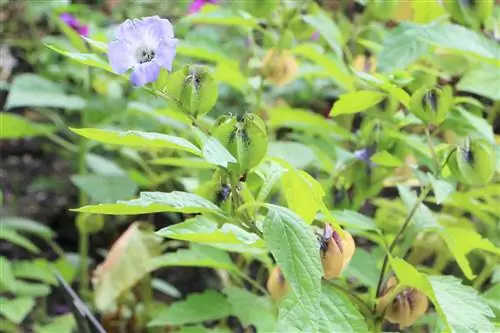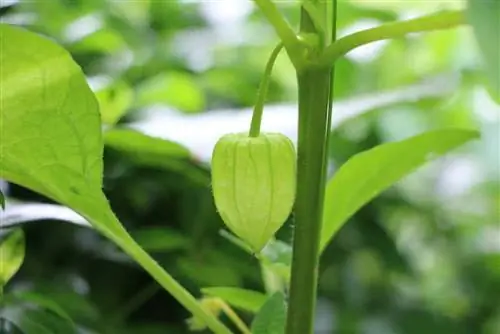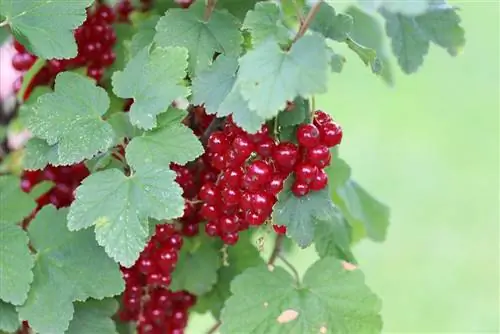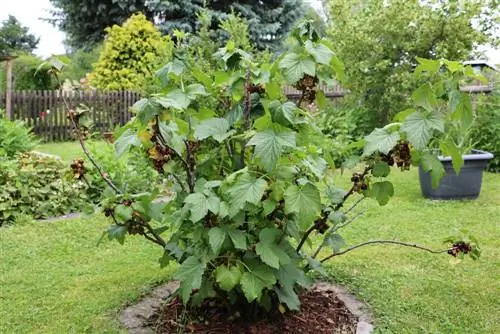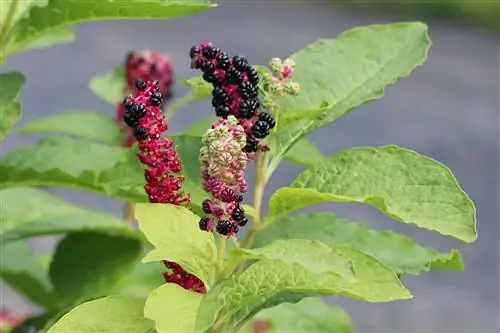- Author admin [email protected].
- Public 2023-12-17 03:39.
- Last modified 2025-01-24 12:45.
The Andean berry is a member of the nightshade family. With a garden design that is close to nature, the exotic plant becomes a real eye-catcher. Planted together with autumn bloomers such as asters, the result is a harmonious interplay of colors. The he althy fruits of Physalis peruviana are eaten raw or used as a garnish for desserts and cocktails. Since they are relatively easy to cultivate and are quite expensive commercially, more and more hobby gardeners are trying to grow Andean berries.
Andean Berry Care
The cultivation of Cape gooseberries is similar to that of tomatoes. The plants need a lot of sun, water, hardly any fertilizer and do not need to be cut back. It is also not necessary to thin out.
Site conditions
The Andean berry is a true sun child. Their fruits ripen particularly well in sunny places. It can be cultivated both in the container and in the garden. If the nightshade plant is too dark, the plant takes revenge with fewer flowers and fruits.
- warm location with direct sunlight
- sheltered place
Soil conditions
The substrate should be loose, nutrient-poor, calcareous or enriched with some humus. Since Andean berries spread like bushes, it makes sense to plant the Physalis at least 60 centimeters apart.
Watering and fertilizing
The exotic plants don't like feet that are too dry or too wet. Nevertheless, growth depends on watering behavior. If the Physalis peruviana is watered a lot, it bears a lot of fruit. Overwatering should be avoided. If the plant is grown in a pot, it needs more water.
- normal water requirements for outdoor plants
- cultivated in a pot it needs a lot of water
- don't let it dry out
The plants usually do without additional fertilizer because they are self-sufficient.
- If there is excess fertilizer, the plant reacts with strong shoot growth
- the result is few flowers and therefore hardly any fruit
- Andean berries in pots, on the other hand, need fertilizer every four weeks during the growth phase
Cutting
A cut only makes sense if the crop has been grown for several years. The exotic plant does not need to be cut or trimmed. Otherwise:
- is the Cape gooseberry cut back in spring
- cut to half or a third of the plant height
- Sizing is not recommended
Propagate
Propagation from seeds
- Sowing in February
- Place seeds on potting soil and cover with a little soil
- keep evenly moist, not wet
- keep bright and warm, at 25 °C
- A mini greenhouse is optimal
- Avoid direct sunlight
- ventilate regularly
- Germination time about a week
- If the first leaves after cotyledons are present, they can be pricked out
- Shortening the roots promotes branching
Tip:
If you don't want to pick the seeds out of the fruit individually with a toothpick, simply spread the pulp on kitchen paper and let it dry. Then collect the seeds and plant them.
Propagation by cuttings
- cut 10 cm long side shoots in autumn and pot them up
- If the cutting rots due to unfavorable winter quarters, perhaps cut new offshoots in February
- Place the lower third in potting soil
- Keep substrate constantly moist
- put them outdoors or in the bucket after the “Ice Saints”
Wintering
Since the Physalis is not hardy, it should move to winter quarters before the first frosts. A greenhouse or winter garden are ideal locations. Unripe fruits continue to develop and can be harvested in winter. If you cultivate the Andean berry outdoors, you should cut it back heavily and repot it in pots.
- As an evergreen plant, it needs a bright location
- Overwintering cool, but not cold
- ideal temperature is 5 to 10 °C
- water rarely, do not let it dry out
Tip:
If you have space problems, simply cut cuttings in autumn and overwinter.
Diseases and pests
Diseases are of no importance for the Andean berry. However, if there is a lot of moisture, gray mold rot (Botrytis) can occur. A sufficient planting distance solves the problem. Among the pests there are whiteflies and aphids. These can be easily combated with biological means.
Frequently asked questions
Are Physalis berries poisonous or edible?
Some species such as the Chinese lantern flower (Physalis alkekengi) are poisonous. Varieties such as Physalis peruviana and Physalis pruinosa (earth cherry) are edible and extremely tasty.
Do the fruits of the Andean berries continue to ripen?
No, because they are non-climacteric (non-ripening) fruits.
Which planting partners are suitable for the Cape gooseberry?
Potatoes, tomatoes, eggplants and peppers are not recommended. However, the exotic plant goes well with lettuce and beans. Among the ornamental plants, the plant prefers asters, chrysanthemums or bluebells as planting partners.
Tips for speed readers
- Andean berry, also called Cape gooseberry, bladder cherry or lantern flower
- from the nightshade family
- 90 known species worldwide
- mostly annual plant
- Physalis peruviana is edible
- Location: full sun, bright, sheltered from the wind
- loose, nutrient-poor soil, enrich with humus
- normal water requirements as an outdoor plant
- cultivated in pots, the Andean berry needs a lot of water
- don't let it dry out and don't keep it too moist
- no additional fertilizer necessary as self-sufficient
- annual plants do not require pruning
- cut perennial plants to half or a third of the planting height
- sparing unnecessary
- Propagation from seeds and cuttings possible
- Wintering: cool, bright, at 5 to 10 °C
- Pests: whiteflies and aphids
- Diseases: sometimes gray mold rot
What you should know about the Andean berry soon
The Andean berry is usually perennial, but we usually grow it as an annual. It is simply not frost resistant. The plants take up quite a bit of space and grow very sprawling. The shoots break off easily. You should definitely tie them up. The plant is grown with multiple shoots and must become beautifully bushy. The fruits require a long ripening time. In our latitudes they often do not fully ripen. But only ripe berries taste good.
- The Andean berry likes it warm and absolutely sunny. A place protected from the wind is best so that the long shoots don't break off.
- The planting substrate should be neither too wet nor too dry, similar to tomatoes.
- It can be nutrient-poor and acidic, neutral or calcareous.
- The planting distance should be about one meter, as the plant spreads quite a bit like a bush.
- You don't have to pour too much. The plant ball should not dry out either.
- Cutting is only necessary for perennial crops. Then in the spring you cut back really hard to 1/3 to ½.
- Diseases are hardly known. Whiteflies appear as pests from time to time.
The plants are very sensitive to frost. They do not survive any sub-zero temperatures. You can also overwinter the Physalis; they are actually perennial plants. Overwintering must be bright and cool, but not cold. Temperatures around 15 °C are best.

